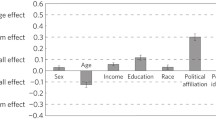Abstract
High school students' ideas about the greenhouse effect and global warming have been sought using a closed-form questionnaire. The students, 702 in all, ranged from grades 5 to 10 across a spectrum of schools, and the incidence of a number of ideas, and the strength with which they are held, have been quantified. Using factor analysis, common themes within students' thinking have been identified; from the nature of the questions posed, and the way in which these ideas are grouped, it appears possible to key into the conceptualization of this phenomenon in the minds of the students. The most general conclusion to be drawn from these results is that many students appear to confuse different major environmental problems. In particular, logical and apparently consistent models are held for the confusion between global warming and ozone-layer depletion. In a similar, but less dramatic fashion, there is a linking to radioactive contamination, acid rain, and even global biodiversity reduction. Within the minds of students, the origins of one problem are confounded with the origins of the others, the repercussions of one are confused with the repercussions of the others, and any environmentally friendly action might be said to help any environmental problem.
Similar content being viewed by others
References
Ausubel, D. (1968).Educational Psychology: A Cognitive View Holt, Reinhart & Winston, New York.
Boyle, S. (1989).The Greenhouse Effect Hodder & Stoughton, London.
Child, D. (1979).The Essentials of Factor Analysis Holt, London.
Gates, P. (1992).The Aliens are Coming — Plant Life and the Greenhouse Effect Puffin Books, London.
Gribbin, J. (1990). An assault on the climate consensus.New Scientist December 15, 1990: pp. 26–31.
Houghton, J. T., Jenkins, G. J., and Ephraums, J. J. (1990).Climate Change: The Intergovernmental Panel on Climate Change (IPCC) Scientific Assessment CUP, Cambridge.
Mitchell, J. (1990). Greenhouse physics.Physics World 3(6): 27–32.
Spitzer, W., and Wilcox, J. (1991). Global ecology: Taking school science into the field,Hands On 14(1): pp. 1–2.
Stanisstreet, M., and Boyes, E. (1990). Human influences and influencing humans: Attainment target 5 of the national curriculum.School Science Review 72(259): 144–145.
Steven, M. D. (1991). Monitoring the terrestrial biosphere.Physics Education 26: 169–171.
Tickel, C. (1991). The quality of life: What quality? Whose life? Address to the British Association for the Advancement of Science, Reported in theIndependent newspaper, August 27, 1991.
Time, (1992). The summit to save the earth.Time 139(22): 39–65.
Author information
Authors and Affiliations
Rights and permissions
About this article
Cite this article
Boyes, E., Chuckran, D. & Stanisstreet, M. How do high school students perceive global climatic change: What are its manifestations? What are its origins? What corrective action can be taken?. J Sci Educ Technol 2, 541–557 (1993). https://doi.org/10.1007/BF00695323
Issue Date:
DOI: https://doi.org/10.1007/BF00695323




